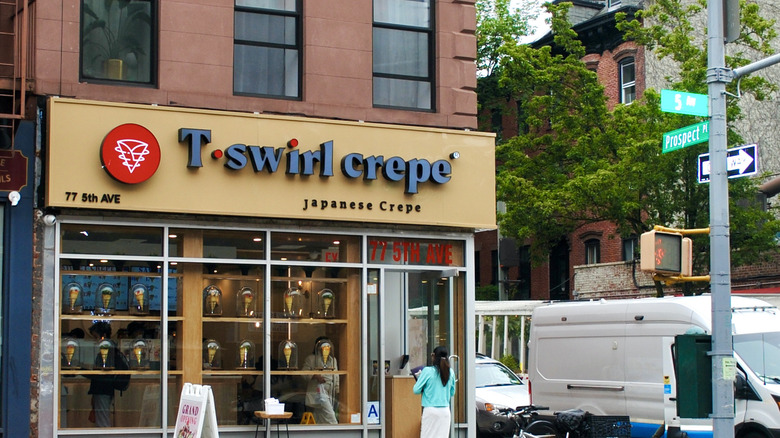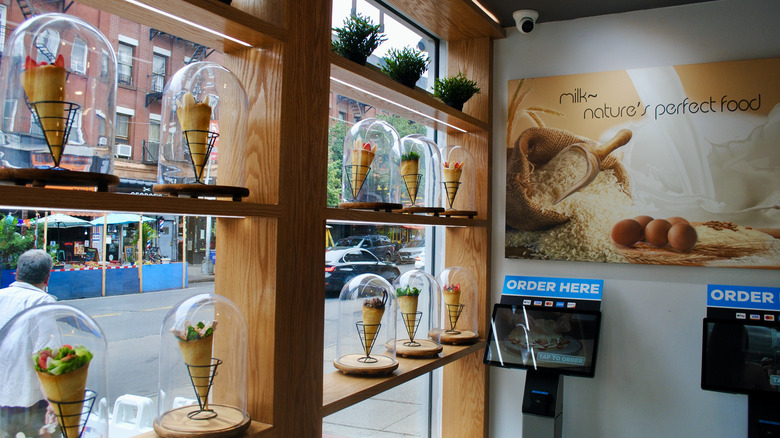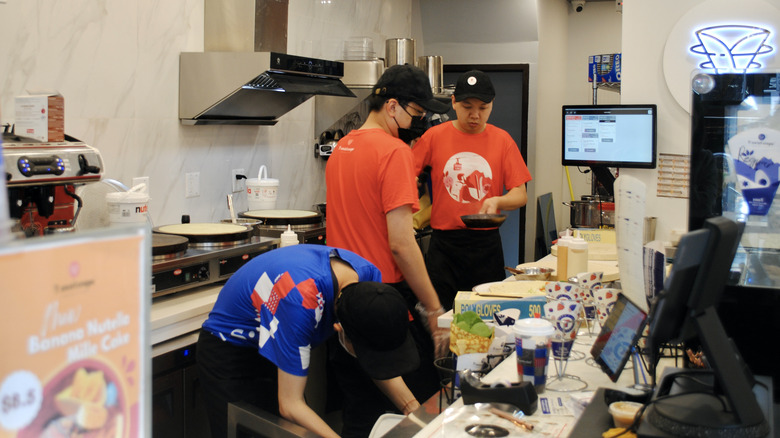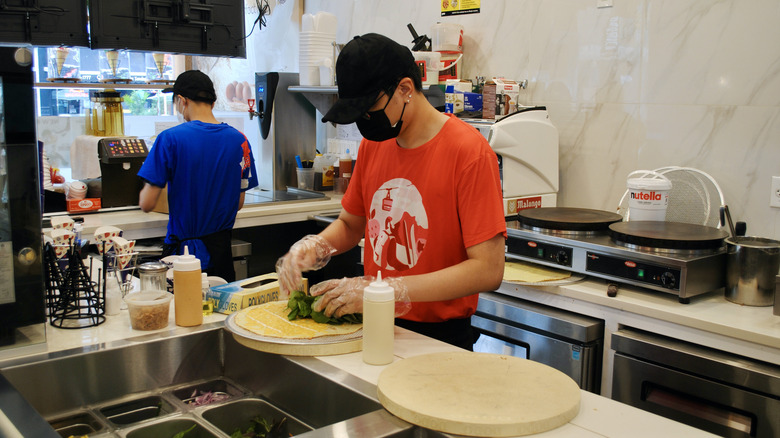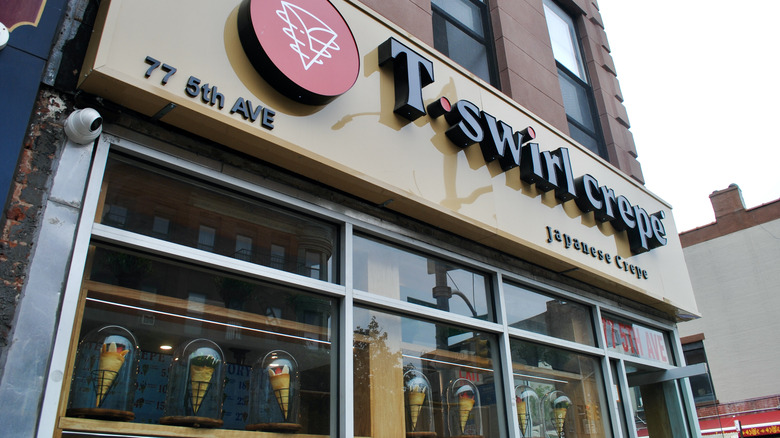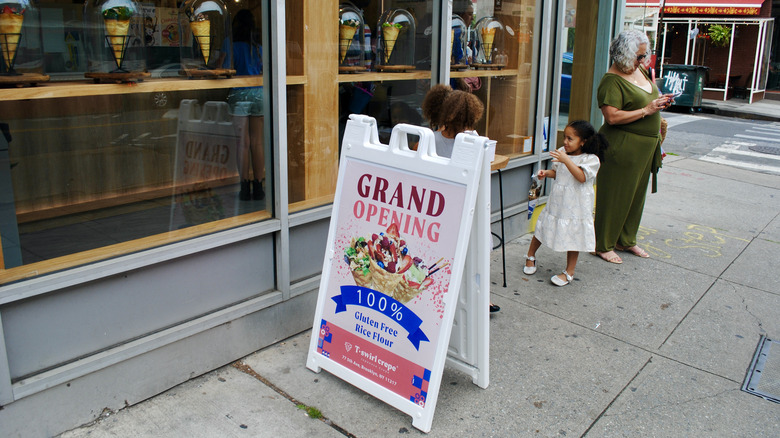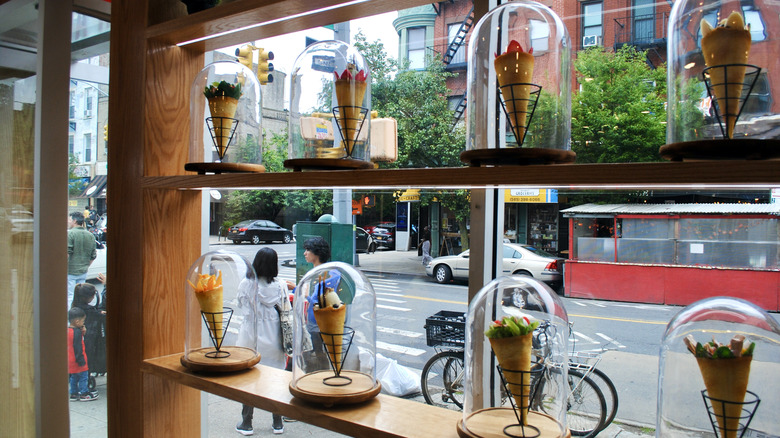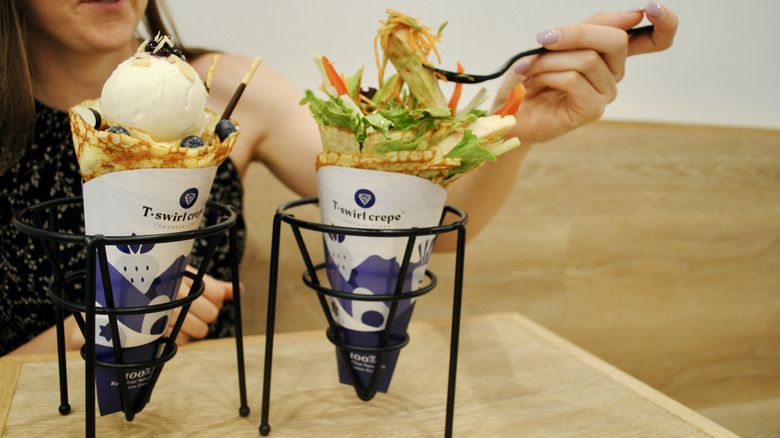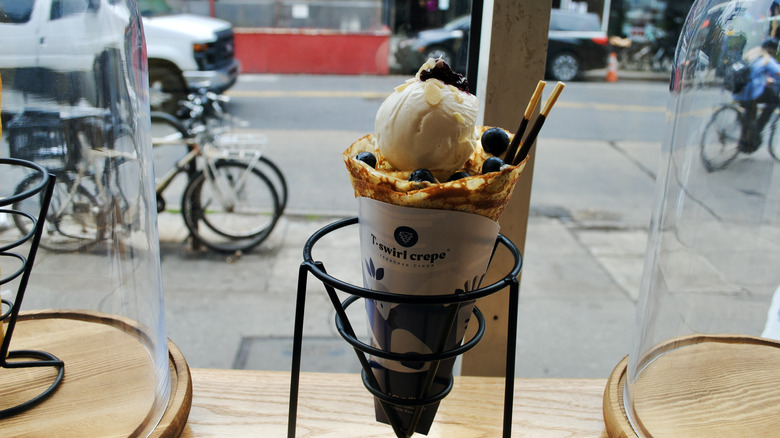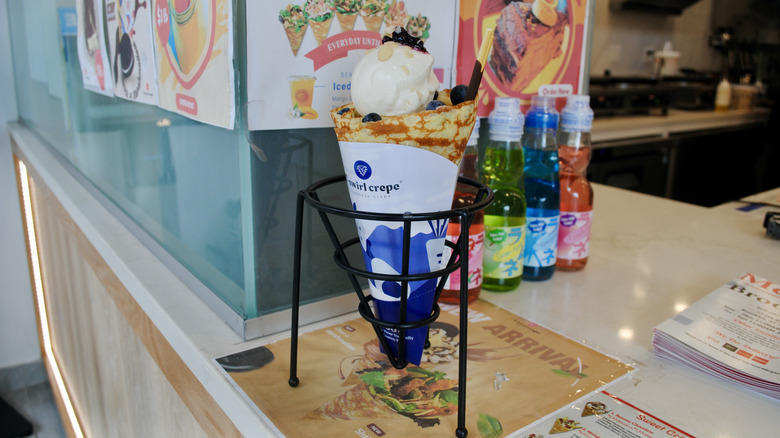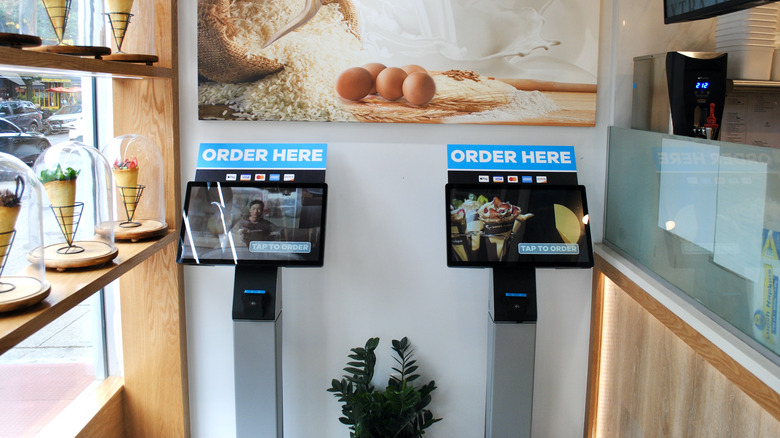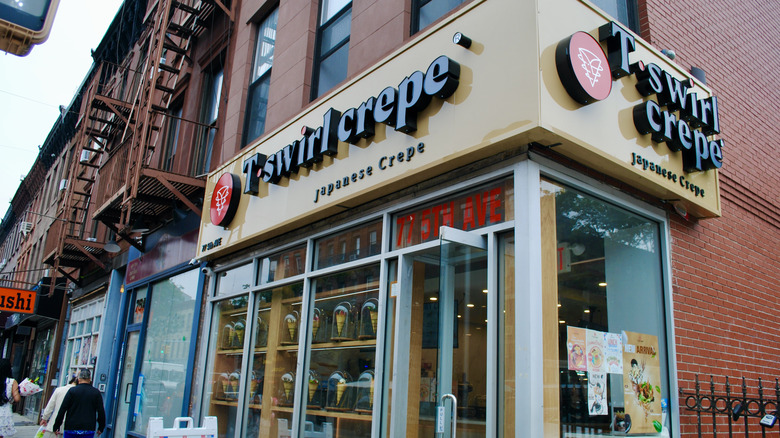What To Know About T-Swirl Crepe, The Popular Japanese-Inspired Dessert Chain
Once you start noticing these little shops labeled "T-swirl Crêpe" on the streets of New York, it's hard to stop — there's one in Flushing, Queens, another in the Ukrainian village, a third in Manhattan's Chinatown, and now yet another on Park Slope's Fifth Avenue in Brooklyn. The proliferation of this Japanese creperie acts as evidence in and of itself that T-swirl Crêpe is quickly building a big brand. The red logo features a curiously conical crepe surrounded by a circular cage; plastic mock-ups of the crepes are arranged in rows in the window, each in a glass bubble. The crepes themselves look like ice cream cones stuffed high with all manner of ingredients, from chunks of Angus beef to Pocky sticks. Unless you know Japanese crepes well, you're probably left wondering what makes them different from a classic French crepe and what those savory and sweet flavor combos could possibly taste like.
To find out more about what makes this Japanese creperie tick, we talked to Jerry Lin, the founder of T-swirl Crêpe. Here's what he had to say about what you need to know about this blossoming brand.
Japanese crepes are different from French crepes
Japanese crepes hail from — you guessed it — Japan, where street vendors have created a specialty that's decidedly different from the original French version of this dish. At first, Japanese crepes were inspired by French cuisine: The first Japanese creperie, a patisserie called Marion Crêpes, opened in 1976 in Harajuku. The trend caught on quickly. The French-inspired sweet treat is also sometimes called a Harajuku crepe as a result, and Marion Crêpes persists today as a large chain, a testament to the popularity of this Japanese crepe variation.
Despite the fact that Japanese crepes were inspired by French ones, there are certainly ways to tell them apart. A Japanese crepe is thicker and larger in diameter than a traditional French crepe. They are also folded differently; French crepes are usually folded into a flat triangle, while Japanese crepes, like the ones served at T-swirl, are cone-shaped. Typically, French crepes are considered a dessert, while the Japanese variety can be regarded more as street food, with the savory options just as popular as the sweet ones.
What makes T-swirl Crêpe different
"My Japanese crepe is something innovative," Jerry Lin said. "We change the way people normally eat crepes — usually, they use forks and knives, but now they eat the cone; we prepare all fresh ingredients; we play around with ingredients to combine them together and make different flavors."
Not only are the crepes at T-swirl fresh, but they are also naturally 100% gluten-free: "It's a rice flour batter," Lin shared. "Some Japanese crepes are soft. My recipe makes ours crunchy." The consistency of the crepes at T-swirl, that crunchy outside, soft inside experience, is what differentiates the crepes here from other Asian creperies.
Another thing that makes T-swirl special is its founder's adamant insistence on the importance of good customer service. While reflecting on his time cooking Japanese cuisine, Lin told Tasting Table that the thing which personally drives him is the satisfaction and pleasure customers get at T-swirl Crêpe. Seeing smiling customers gives Lin an "incredible feeling" that puts customer service at the core of T-swirl.
T-swirl Crêpe has a very literal name
T-swirl Crêpe isn't just a cutesy phrase: In fact, this creperie's name is entirely informational. T-swirl Crepe is actually named for the instrument that crepe-makers use to apply batter to the crepe pan, which is shaped like the letter T. It plays an important part in the process of crepe making, according to Jerry Lin. "We use the T-shaped wooden spreader to swirl the batter on the hot pan to make the crepe."
This is not just a practice at T-swirl Crêpe but rather a tradition: In order to make a traditional Japanese crepe, the crepe maker starts with a batter that is very thin, made from flour, milk, and eggs. They pour a dollop of crepe batter onto an already-hot pan and then take out their handy T-shaped tool and use it to swirl the batter in a circular motion around the pan. This motion ensures that the crepe will be of the same thickness throughout, as well as creating a perfectly circular shape. The T-shaped swirling tool is the trick to a foolproof crepe, but using it takes practice, and so it's vital to a consistent product across locations.
Founder Jerry Lin comes from China, but loves Japanese cuisine
Jerry Lin is actually from Fujian, China. When he originally came to the U.S. in 2000, he shared that his first ever job was as a server in a Japanese restaurant, where he earned a promotion to cook after a year. Lin followed his passion and became a chef within months. He reports loving this introduction to the food industry and talked with Tasting Table excitedly about how inspired he was by both the food he was cooking and the people he met while doing it. "I worked for a decade, and I fell in love with Japanese culture," Lin said.
After leaving that job, Jerry Lin decided to go into business for himself. He wanted to hop on the zeitgeist of the moment, and since this was back in 2013, that meant he would go on to open a fro-yo shop. "I did start my first business as a yogurt store," Lin said with a laugh. "At that time, frozen yogurt was very popular."
Shortly after Lin opened up, though, American society at large discarded its infatuation with frozen yogurt, and the decline has continued since. Lin remembers the saturation of froyo stores in New York City at that time and says that it inspired him to find a food concept that would be new, different, and exciting.
The first T-swirl Crêpe opened in 2014
After the end of his would-be frozen yogurt empire, Jerry Lin went back to the drawing board to figure out a new business idea that would set him apart from other businesses while resonating with American eaters. He wanted to find a concept that he wouldn't be late to the game for. As Lin explained to Tasting Table, "I started searching for a new idea, something new that I could bring to the U.S. market."
Although he himself was not Japanese, the passion for Japanese cuisine that he had cultivated while cooking Japanese food became useful. His research prompted him to consider Japanese crepes, which weren't really making a mark in America yet. Lin explained, "In America, in 2014, we didn't have a lot of options for the crepe. Just French crepes." Unlike Lin's fro-yo business, with Japanese crepes, he would be able to carve out an original niche while also paying homage to a cuisine he greatly admired.
Japanese crepes have been trendy across Asia for a while
Although Japanese crepes weren't popular yet in America when Jerry Lin stepped onto the scene, they were already having their moment in countries across Asia. "Back in 2014, we found Japanese crepes [were] very popular in Asia," Lin said. "In Taiwan, Singapore, and of course, especially in Japan."
In fact, Japanese creperies were in the midst of a boom and, since then, have achieved staple street food status. There's a whole street in stylish Harajuku called Takeshita Dori, where all you can buy are crepes from different vendors. Much like the city of Harujuku, which is considered a teen haven, Japanese creperies have historically (for the most part) been marketed towards young women, with cute graphics and names like "Come on, Sweet Girls." Despite all the crazy hype in Japan, the crepes hadn't made a dent in the U.S. food scene before T-swirl, so Lin felt hopeful about bringing this simple concept to America.
Savory crepe flavors make for a surprisingly hearty meal
Japanese creperies typically offer both savory and sweet crepes in a dizzying array of flavors, a sheer variety made possible by the permutations of ingredients available. Jerry Lin said that he and his team work together to create the flavors on offer at T-swirl: "For the recipes, I collaborate with my team, especially with French and Asian chefs, to create a taste that isn't necessarily Asian or French or American — that's for everybody."
There are 14 savory options on offer at the time of publication, recipes that rotate in and out seasonally, featuring Japanese-inspired crepes like chicken teriyaki and American flavors like the T-swirl BLT. "The spicy crab meat crepe is a perfect example of fusion," Lin said, remarking on how he brought flavors typically associated with sushi rolls together in a crepe format. He also thinks of the Angus short ribs flavor as a highlight of the menu. "We order from premium suppliers for the Angus beef, which makes for a truly indulgent taste. ... [and] the Thai chicken is my favorite crepe," Lin shared.
We got to try the Thai chicken crepe, which combines strips of chicken breast with a mix of lettuce leaves, cucumbers, red peppers, and julienned carrots. The salad inside this crepe is tossed with a Thai dressing and wasabi tofu sauce, which adds some tingling heat. We loved the flavors and the freshness of the crepe, and we were surprised by how filling it was.
Sweet crepes are a great dessert for two
Meanwhile, on the sweet side of the menu, you can choose from classic crepes like strawberry Nutella or go in a more jazzy direction by ordering a matcha adzuki bean. Jerry Lin feels strongly about including multiple crepe options with fresh fruit: "I'm a father, so I love encouraging people to consume more fresh and healthy options," he told Tasting Table. As such, the sweet crepe flavors are based on fruits like mango, lychee, and wild berries.
Despite his promotion of healthy eating, Lin's favorite sweet crepe is one of the most decadent ones on the menu. "The matcha chocolate truffle [is] at the top of my list," Lin shared. He told us that this crepe earns a particularly special spot as it's a personal recipe of his. The chocolate is made in-house, paired with a matcha custard cream, and features crushed pistachio.
We got to sample the blueberry cheesecake crepe, filled with three different types of dairy: Whipped cream cheese, custard cream, and whipped yogurt. Fresh blueberries and a blueberry reduction offset the heavy milk content, then the crepe cone is topped with a mound of vanilla gelato and Pocky sticks. All 600 calories of this dessert make it almost overwhelming, so we'd recommend sharing with a buddy. Oh, and unless you want a mess on your hands, get the gelato on the side!
T-swirl Crêpe locations are community-focused
When it comes to introducing new foods to America's dining scene, it can often be an uphill battle. Jerry Lin's strategy was to focus on places where his food would already be understood. "I chose Flushing as the first location because ... a big Asian community lives there," Lin said.
T-swirl has since expanded to other locations in historically Asian communities, like Chinatown and a new location in Elmhurst, Queens. As the business grows, the T-swirl strategy is to build a strong basis of support from community members for whom Japanese crepes might be a nostalgic food.
However, Lin thinks that the general American public is ready to embrace Japanese crepes, and he'd like to be at the helm of the education effort necessary to make that happen. At the time of publication, T-swirl Crêpe has 33 official stores across 13 states, some of which are franchised. Lin's goal for the brand? To make Japanese crepes a top daily consideration for hungry people.
What to expect at each T-swirl location
Interestingly, unlike some bigger brands, Jerry Lin isn't as pressed about brand consistency, hoping that every additional location of the creperie will feel unique. "For us, our strategy is that every store gives customers a different vibe. From Manhattan to Queens to Brooklyn, we want customers to come to different T-Swirls and say, 'Wow, this looks different. This looks cool.' It depends on the location."
Still, some things will remain the same: At T-swirl Crêpe, there's an option to either order at the cash register or on a touch screen up front. It's a fast-casual spot, not unlike a Shake Shack. Once you've ordered, you can stand and watch your crepe being swirled or take a seat at a table to wait until they call out your name. When your order is ready, there is space where you can eat your crepe in-store, in which case the waitstaff will hand it to you in a conical wire basket that models as the T-swirl logo. Or, you can opt to take your food to-go, in which case you'll be handed a triangular, see-through plastic bag that is the exact size of your crepe. Make sure to get a fork and knife, no matter where you plan on eating your crepe — these things can get messy.
Where to find T-swirl Crêpe
Most of the locations of T-swirl are currently centered in the Northeast, with 12 locations in New York; there are also a smattering across the middle of the country, like in Las Vegas, Wichita, and New Orleans, and a few have even made it to the West Coast. Jerry Lin is hopeful for even more expansion: In the coming year, he said, "My hope is to expand the reach from the current 33 locations to 100 locations and strengthen the community to be a wider and more diverse customer base."
These new locations won't just be cookie-cutter copies of the other T-swirl locations, and they're already on their way: Lin told us that the final details are being put to bed on a new location in Williamsburg, Brooklyn and that another spot will be dropping in Jackson Heights, Queens soon after. On the franchising front, T-swirl has new locations opening soon in Oklahoma and Riverside, California. They're also doing catering now. There's much on the horizon for this fast-casual creperie, and fans of the food can expect the future to be painstakingly planned and filled with passion for good eats.
